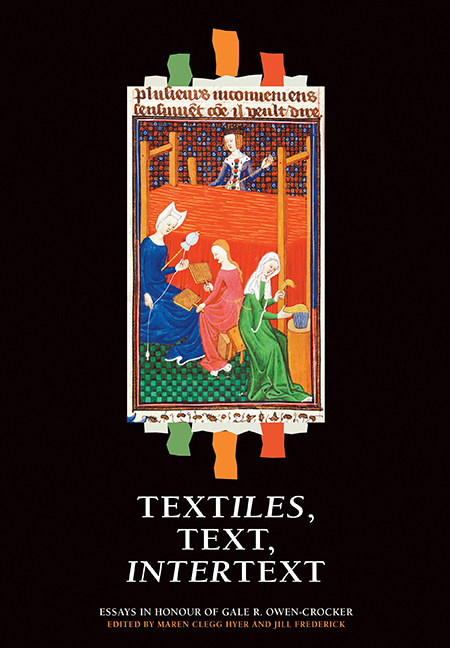Book contents
- Frontmatter
- Contents
- List of Illustrations
- List of Abbreviations
- Introduction
- A Personal Recollection
- List of publications of Gale R. Owen Crocker
- Part I Textile
- Part II Text
- 6 Text, Textile, Context: Aldhelm and Wordweaving as Metaphor in Old English
- 7 The Weft of War in the Exeter Book Riddles
- 8 Fyrenne Dracan in the Anglo-Saxon Chronicle
- 9 Old English in the Margins
- Part III Intertext
- Index
- Tabula Gratulatoria
7 - The Weft of War in the Exeter Book Riddles
from Part II - Text
Published online by Cambridge University Press: 05 July 2016
- Frontmatter
- Contents
- List of Illustrations
- List of Abbreviations
- Introduction
- A Personal Recollection
- List of publications of Gale R. Owen Crocker
- Part I Textile
- Part II Text
- 6 Text, Textile, Context: Aldhelm and Wordweaving as Metaphor in Old English
- 7 The Weft of War in the Exeter Book Riddles
- 8 Fyrenne Dracan in the Anglo-Saxon Chronicle
- 9 Old English in the Margins
- Part III Intertext
- Index
- Tabula Gratulatoria
Summary
Two riddles in the Exeter Book, Riddles 35 and 56, use language plainly associated with the craft of weaving, and are almost without dispute solved respectively as “mailshirt” and “loom”. Erika von Erhardt-Siebold expanded the group by offering her well-considered solution of “shuttle” for Riddle 70, while Craig Williamson added the only Latin riddle of the manuscript, Number 90, to the collection of “textile riddles” with his solution of “web and loom”. In general, the limited scholarly attention given to each of these riddles has delineated the ways that their details corroborate material evidence for weaving or implements associated with that activity during the Anglo-Saxon period. While this approach to the riddles describes important features of weaving technology and provides crucial understanding of a vital industry, solutions to the riddles solely based in the material become a catalogue of parts rather than an explanation of their literary and artistic qualities. What I will undertake here is to show that the diction of these riddles redirects and inverts conventional assumptions about Anglo-Saxon gender roles; the texts subtly interweave the language of martial endeavor and material production to reveal an unexpected fluidity between masculine and feminine cultural norms. Gale R. Owen-Crocker's pioneering work in the area of medieval textiles and textile production has profound implications far beyond its immediate focus; this present study could not have existed without her research, and represents just one example of her scholarly influence. It also serves as a tribute to her academic generosity and her own personal kindness.
The discussion of Riddles 35 and 56 by von Erhardt-Siebold exemplifies the material perspective. It describes in detail early looms and their weaving processes, explaining how the poetic diction expresses the material techniques. For instance, she notes of line 6 in Riddle 35, “ne þurh þreata geþræcu þræd me ne hlimmeð” (which she translates as “with me no pressing of the crowded many makes a thread resound”):
The resounding threads in [this line] can only be the taut warp-threads, but the “pressing of the many” may refer to the numerous threads of either the warp or the weft, that is, the shuttle pressing or striking on the warp-threads, or to the batten first striking on the warp and making it resound and then pressing on the weft-threads.
- Type
- Chapter
- Information
- Textiles, Text, IntertextEssays in Honour of Gale R. Owen-Crocker, pp. 139 - 152Publisher: Boydell & BrewerPrint publication year: 2016



